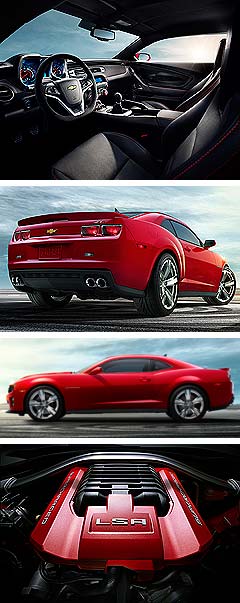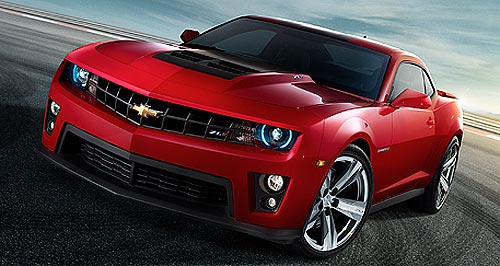Make / Model Search
Future models - Chevrolet - Camaro - ZL1Chicago show: GM springs 410kW blown V8 CamaroHigh performance: GM vice president global design Ed Welburn with the supercharged Camaro ZL1. Chev pumps up Camaro with supercharged 6.2-litre V8 for 2012 launch10 Feb 2011 A SUPERCHARGED 6.2-litre V8 Camaro packing 410kW of power has been previewed at the Chicago motor show ahead of a 2012 launch. Called the ZL1 in homage to an iconic Camaro racing engine of the same name in the 1960s, the fastest official Camaro ever built is powered by General Motors’ blown LSA engine that made its debut in supercharged form in the 2009 Cadillac CTS-V. Apart from 96 more kilowatts than the standard V8 Camaro, the top-shelf coupe will also be beefed up in critical areas, including the chassis, transmission and rear axle assembly. Styling has also been enhanced to match the increased grunt, creating a new performance benchmark for the American muscle car’s fifth-generation, which was designed and engineered in Australia on Holden’s Zeta platform. While Holden has ruled out the Camaro for Australia, at least in this generation, it is less clear if the supercharged version of the 6.2-litre LS3 V8 will make it to Australia under the bonnet of a future Holden Special Vehicles (HSV) model to counter rival Ford Performance Vehicle’s (FPV) locally developed supercharged ‘Miami’ 5.0-litre V8.  Holden’s official hot shop has taken regular updates of GM’s LS engines in the past, and while it is not commenting on future model plans, it has not ruled it out. Holden’s official hot shop has taken regular updates of GM’s LS engines in the past, and while it is not commenting on future model plans, it has not ruled it out.The Camaro is based on the same rear-drive platform as the HSV E-Series, meaning much of the engineering work required to transplant the blown engine into the Zeta chassis could already be complete. HSV’s most powerful engine currently is the normally-aspirated 325kW/550Nm 6.2-litre LS2 as used in the GTS and Grange. In the blue corner, FPV’s locally developed supercharged version of Ford’s 5.0-litre Coyote engine for its GT range develops 335kW and 575Nm. FPV has said there is more performance where that came from, but whether it could pull 410kW out of a 5.0-litre engine to match GM’s new blown small-block V8 is debatable. While the LSA V8 from GM is impressive, its power still falls short of the 460kW produced by HSV sister company Walkinshaw Performance’s similar supercharged V8 in its Commodore-based WP Series II. That limited-edition HSV car, benefiting from an Edelbrock supercharger and other tweaks from Walkinshaw engineers in Melbourne to generate 780Nm of torque, was launched at last year’s Australian International Motor Show in Sydney, with just 23 examples slated for production. According to GM, the new Camaro’s LSA V8 produces 677Nm of torque. No performance figures were released, with GM saying they would be announced later in the year when the car’s development is more advanced. Chevrolet said the development goal for the Camaro ZL1 was to reach optimal lap times on top road-racing circuits and excellent driving dynamics on the street. For the first time, a Camaro gets Magnetic Ride Control – a feature already used by HSV on its Commodore-based E-Series range – and electric power steering. Apart from an intercooled four-lobe Eaton supercharger, the LSA engine gets premium heat-resistant aluminum-alloy cylinder heads, lightweight reciprocating assembly, high-strength pistons and piston oil squirters. A dual-mode exhaust – as used on both Corvette and HSV models – has been added. Electric power steering cuts power losses from a traditional pump, while the engine drives the rear wheels through a heavier, high-torque version of the six-speed Tremec manual gearbox with a dual-mass flywheel and twin-disc clutch for easy operation and shift smoothness. The gear shift throw has been shortened for quicker shifts. At the back, the drivetrain has been beefed up with a stronger driveshaft, larger and stronger cast iron differential housing, stronger axles and heavy-duty limited-slip differential. Apart from the Magnetic Ride Control, the suspension gets repositioned rear stabiliser bars with drop links outboard of the control arms for less body roll. Six-piston, Brembo disc brakes employing two-piece 370mm rotors combine with four-piston 365mm rear brakes to provide extra stopping power. Body wise, the ZL1 gets a new front fascia and bonnet with air extractors for extra downforce. The vents in the bonnet are fashioned from carbon fibre and are painted matt black. New 20-inch wheels – fitted with tyres developed by Goodyear especially for the ZL1 – combine with reshaped rocker panels, redesigned exhaust tips and a sprinkling of ZL1 badges complete the exterior package. Inside, enhancements include microfibre inserts in the front seats, a redesigned steering wheel, alloy pedals, head-up display with unique performance readouts and a “four-pack” auxiliary gauge system featuring a boost readout. The Camaro ZL1 was presented at Chicago by GM vice president global design Ed Welburn, who said everything about the ZL1’s design was directly related to its technology and serious performance, especially aerodynamics. “Our designers’ goal was to execute that function-oriented design with beautifully sculpted forms, creating an imposing, powerful persona,” he said. “Function becomes the aesthetic. The intent is a car that delivers on the attitude it projects.” Chevrolet’s marketing vice-president Rick Scheidt said the company had revived the name from the 1960s Camaro all-aluminium track V8 engine that was installed in just 69 cars, achieving mythical status among Camaro fans as the pinnacle in Camaro performance. “It’s the most technically advanced Camaro ever, so we’ve chosen a name from the most elite and exclusive Camaro in history,” he said. The ZL1 will be available in all regular Camaro exterior colours, but only with a black interior.  Read more18th of January 2011  Top-selling Camaro a boost for HoldenChevy’s sports coupe finally outsells its five-decade long Mustang foe in America17th of November 2010  LA show: Chevy Camaro soft-top out in full sunAussie-developed Chev Camaro convertible debuts ahead of production early in 20114th of November 2010  Chev Camaro awarded ‘hottest car’ honours at SEMAGM’s Aussie-engineered Camaro is the US aftermarket’s most popular carAll future models Alfa Romeo Alfa Romeo Abarth Abarth Alpine Alpine Alpina Alpina Audi Audi Aston Martin Aston Martin BMW BMW Bentley Bentley Chery Chery Brabham Brabham Chrysler Chrysler Chevrolet Chevrolet Cupra Cupra Citroen Citroen DS DS Dodge Dodge Fiat Fiat Ferrari Ferrari Foton Foton Ford Ford Great Wall Great Wall FPV FPV Haval Haval GWM GWM Honda Honda Holden Holden Hummer Hummer HSV HSV Infiniti Infiniti Hyundai Hyundai Jaguar Jaguar Isuzu Isuzu Kia Kia Jeep Jeep Land Rover Land Rover Lamborghini Lamborghini Lexus Lexus LDV LDV Mahindra Mahindra Lotus Lotus Mazda Mazda Maserati Maserati Mercedes-AMG Mercedes-AMG McLaren McLaren MG MG Mercedes-Benz Mercedes-Benz Mitsubishi Mitsubishi Mini Mini Opel Opel Nissan Nissan Peugeot Peugeot Pagani Pagani Proton Proton Porsche Porsche Renault Renault Ram Ram Rover Rover Rolls-Royce Rolls-Royce Skoda Skoda Saab Saab SsangYong SsangYong Smart Smart Suzuki Suzuki Subaru Subaru Toyota Toyota Tesla Tesla Volvo VolvoMotor industry news |
Click to shareChevrolet modelsResearch Chevrolet All future models Alfa Romeo Alfa Romeo Abarth Abarth Alpine Alpine Alpina Alpina Audi Audi Aston Martin Aston Martin BMW BMW Bentley Bentley Chery Chery Brabham Brabham Chrysler Chrysler Chevrolet Chevrolet Cupra Cupra Citroen Citroen DS DS Dodge Dodge Fiat Fiat Ferrari Ferrari Foton Foton Ford Ford Great Wall Great Wall FPV FPV Haval Haval GWM GWM Honda Honda Holden Holden Hummer Hummer HSV HSV Infiniti Infiniti Hyundai Hyundai Jaguar Jaguar Isuzu Isuzu Kia Kia Jeep Jeep Land Rover Land Rover Lamborghini Lamborghini Lexus Lexus LDV LDV Mahindra Mahindra Lotus Lotus Mazda Mazda Maserati Maserati Mercedes-AMG Mercedes-AMG McLaren McLaren MG MG Mercedes-Benz Mercedes-Benz Mitsubishi Mitsubishi Mini Mini Opel Opel Nissan Nissan Peugeot Peugeot Pagani Pagani Proton Proton Porsche Porsche Renault Renault Ram Ram Rover Rover Rolls-Royce Rolls-Royce Skoda Skoda Saab Saab SsangYong SsangYong Smart Smart Suzuki Suzuki Subaru Subaru Toyota Toyota Tesla Tesla Volvo VolvoMotor industry news |











Facebook Twitter Instagram